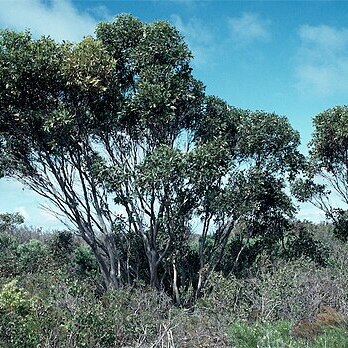Mallee to 5 m tall or shrub to 2m. Forming a lignotuber.Bark smooth throughout, pale grey to dark grey. Branchlets more or less square; lacking oil glands in the pith. Juvenile growth (coppice or field seedlings to 50 cm): stems square in cross-section; juvenile leaves always petiolate, sub-opposite to alternate, elliptical to oblong or ovate, 2–10.5 cm long, 1–6 cm wide, grey-green. Adult leaves alternate, petioles 1.3–2.5 cm long; blade lanceolate, 7.5–15 cm long, 1.7–3.8 cm wide, base tapering to petiole, margin entire, apex acute, concolorous, dull to slightly glossy, green, side-veins at an acute or wider angle to midrib, reticulation very dense, intramarginal vein fairly close to margin, oil glands numerous, irregular, intersectional. Inflorescence axillary unbranched, spreading to pendulous, peduncles rounded to narrowly flattened, 1–2.5 cm long, buds 7, 9 or 11 (?or more) per umbel, pedicellate (pedicels 0.3–0.7 cm long). Mature buds ovoid but narrowed at the join, 0.8–1.1 cm long, 0.6–0.8 cm wide, smooth to slightly ribbed, creamy white, scar present (outer operculum shed early), operculum rounded to bluntly conical, stamens inflexed, anthers cuboid, versatile, sub-basifixed, dehiscing by longitudinal slits, style long and straight, stigma blunt to slightly rounded, locules 4 or 5, the placentae each with 4 vertical rows of ovules. Flowers creamy white. Fruit down-turned, pedicellate (pedicels 0.2–0.7 cm long), truncate-globose to hemispherical, ribbed or wrinkled, 0.8–1 cm long, 1–1.4 cm wide, rim thick, disc usually descending, valves 4 or 5, exserted but fragile. Seeds grey-brown, 1–2.5 mm long, ovoid or flattened-ovoid, dorsal surface very shallowly reticulate, hilum ventral. Cultivated seedling: cotyledons Y-shaped (bisected); stems rounded in cross-section; leaves initially linear and sessile or shortly petiolate for ca 7 nodes, then petiolate, broadly elliptical or less commonly ovate, alternate at node 9 to 15+ or remaining subopposite for many nodes, 2–5 cm long, 0.5–3 cm wide, base tapering, apex rounded, dull, green to greyish green.
More
Adult leaves uncinate; lamina 8–12 cm long, 2–4 cm wide, dark green. Peduncle 15–25 mm long; pedicels thick, 5–8 mm long. Buds ovoid; operculum hemispherical, wrinkled, 5–6 mm long, 7–8 mm wide; hypanthium striate, c. 5 mm long, 7–8 mm wide. Fruits hemispherical to subglobular, 7–12 mm long, 11–15 mm wide.


